Feature Interview with Paul Daley
March, 2001
Paul Daley is the author of the recently self-published Links Golf – The Inside Story. He has developed a great appreciation of golf course architecture, in part by living near the famed sandbelt courses in Melbourne, Australia and in part by making regular visits to the United Kingdom. This love of course architecture shines through in his new book, which provides a unique perspective to studying the appeal of links golf.
1. What inspired you to write Links Golf – The Inside Story?
(a) Increasingly from the mid 1980s, I had heard reports about the unstable nature of British linksland. This hastened my decision to firstly play these shrines, and secondly, write something to help focus world attention upon their tenuous existence.
I was keen to go behind the scenes and conduct my own links scholarship if you like – meeting up with superintendents, architects, engineers, managers, club starters, club historians, happy and disgruntled members to really gain an ‘inside story’ into the health of Links Golf.
(b) Donald Steel’s great book on links golf fired my imagination, but also made me realise the subject could be tackled from a different perspective.
(c) I perceived that many clubs had become complacent/confused towards their own Links welfare. A ‘wake-up’ reminder call was needed.
(d) Growing up in a country where Peter Thomson and Greg Norman had been audible plugger’s of the Old Course, and Links golf in general, many Australian golfers naturally gravitate towards that way of thinking. Our professionals have always fared well in the Open: P.Thomson, IBF, G.Norman and K.Nagle winning Opens, plus J.Newton, W.Grady, M.Harwood, G.Marsh and D.Graham coming very close.
(e) Most of our top courses are found in coastal Capital cities – combating wind is an everyday part of Australian golf. Under those circumstances, you develop an empathy and interest for the British links scene.
2. How many links have you played? What ones haven’t you played that you would really like to?
I have played 31 and walked quite a few others. I would really like to visit the Kent coastline to tackle Royal St George’s, Princes and Royal Cinque Ports. Others earmarked include: Royal Aberdeen, Royal Liverpool, Siloth on Solway, Portstewart, Royal Birkdale and Royal St David’s.
3. What are your thoughts on how Carnoustie played for the 1999 Open Championship?
In my opinion, the Carnoustie Open ‘went for the aspirin but ended up taking the whole container.’ The artificial bottlenecks at driving length forced pronounced lay-ups by the professionals, upon a links already brutally long in its natural state. And lets remember that the wind was a mere ‘zephyr’ compared to its normal ferocity.
There was much politicking going on behind the scenes. And sadly, not enough cross-referencing between the R&A and the Carnoustie ground team – in particular with J.S. Philp, the Superintendent. Poor old John has been vilified for preparing the set-up, but the R&A must have seen and approved of his work during their regular site visits? Surely this august body would have over-ruled him had they considered his treatment inappropriate? No doubt J.S.P had his own agenda and hankered for a return to the ‘old days’ when par was the mark, but the blame must be shared.
On another level, I found it exciting (unlike many Opens in the last 15 years) to observe the ball running like a jack-rabbit across the fields of Barry. Balls skipping over and into burns, plus watching the professionals trying to figure out landing spots from 200 metres was educational. The tournament was not a total disaster, but I don’t think most of us wanted to see 7 over par being the yardstick. Between (ten under par) and (par) is an excellent WIN-WIN result for all concerned over 72 holes.
In the end though, there must have been some red faces among officialdom, and shows up the level of amateurism that pervades the oldest championship. Hopefully, lessons will learned and mistakes not repeated.
4. Critics grouse as to how irrigation has led to the inevitable softening of links. What links impress you as retaining the desired firmness?
Sadly there are few left among the well-known links, but Southerness is one that springs to mind, as does North Berwick. A rule of thumb often applies: Where Clubs have budgetary problems, and therefore interference is minimised, they are forced to be more faithful to the links ideal – mean, lean, spartan, spiteful lies where the running ball rules supreme. Fairway speed is venom, and with excessive fairway watering, a links effectively becomes ‘nobbled’. The chess mentality of ‘Do I lay up with a 3 wood or long-iron’ … is lost, as is the intrinsic links contest.
As for the greens, it is alarming to observe the ball being screwed back (as if on remote control) during the oldest championship. Now I concede that golf clubs have become weapons of precision, and the aerodynamics of balata balls continually improve, but it is skating on thin ice to claim that today’s golfers hit the ball any more squarely than Cotton, Hogan,Thomson and co. Take a look at the old newsreels, quality striking would reveal the ball coming to a reasonable stop – but without the excessive sucking back.
The Old Course incorporated fairway watering for the 1978 Open and many were aghast. Recently, an advanced Toro watering system was installed on the promise that it would allow only the desired amount of water to be utilised – but no more! I am not convinced it was a successful ploy.
Those who access this discussion group are not new to the charms of Links Golf. However, part of the pressure stems from the regular golfer who has only recently awoken from a deep sleep to the excitement of this genre. And so they book holidays galore, (being well-healed) and the big name links become overrun. People travel half-way around the world, they all want to play the No.1. Links, not some of the better quality No. 2’s like Turnberry’s Arran. Clubs panic, as did Carnoustie recently. Superintendent John Philp, told me about the 46,000 rounds they have to accommodate yearly. This doesn’t sound too many but when squeezed into an insidiously short golfing season, fairway watering occurs to protect fairways against widespread scaring.
In all, the very popularity of the game first played over the ancient rabbit warrens, is contributing to the diminishing health of Links Golf. I have laboured the point but the inter-relatedness of the above cannot be under-estimated.
(5) What is your favourite example of a links hole that makes you invent a shot?
(a) The 2nd, 3rd, or 4th shot from Road Bunker when despair sets in!
(b) Negotiating the incredible twists of the GATE green at North Berwick.
(c) Should you miss the green at Dell, Lahinch, thinking like a snooker player to best utilise the side cushions.
(d) The long second shot to Royal Dornoch’s 14th hole.
(e) The many varied ways of playing from the Road at The Old Course.
(f) The pitch shot over the wall at Pit – North Berwick
7. Construct your All-Links Eighteen from non-Open courses, being faithful to the hole number and only selecting one hole from any course.
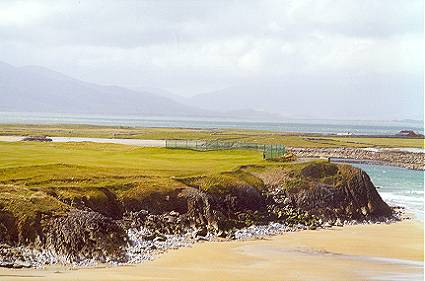
The stunning 2nd at Tralee doglegs right along the cliffs.
- Machrihanish 4
- Tralee 5
- Prestwick 5
- Cruden Bay 3
- Royal Portrush 4
- Royal Dornoch 3
- Gullane No.1 4
- The European 4
- Royal County Down 4
- Struggling here
- Ballybunion ‘Old’ 4
- Dunbar 4
- Elie 4
- Portmarnock 4
- North Berwick 3
- Waterville 4
- Rosses Point 4
- Carnegie Club, Skibo 5
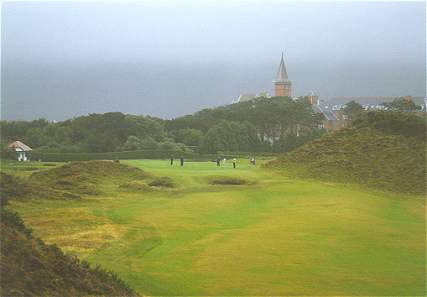
From the crest of the hill at County Down.
8. Which architect’s body of work impresses you when it comes to links architecture? What do you like so much about it?
Nobody yet has been able to surpass the role of Nature, Beast and Man – a combination that Sir Guy Campbell so rightly emblazoned in his legendary 1952 essay on the evolution of linksland. B.Darwin’s book was (and still is) worth buying for those magical few pages alone. The chief role of the early architects was not to route an ingenious links, but just not stuff up the natural advantages already present. Take note Mr Palmer! Still, I do appreciate that the task is not quite ‘shooting fish in a barrel, given wind consideration, and other routing issues.
And so … H.S. Colt did a beautiful make-over of Royal County Down in the late 1920s after ‘Old’ Tom, ‘Arry Vardon, and even Seymour Dunn had their say. Colt embarked upon the widespread planting of gorse and rejigged many holes. The classic 4th hole will always be associated with his name, as will the much admired ‘blind’ 9th. To pave the way for this hole, he eliminated two consecutive blind par threes to conclude the outward half. The 18th hole was remodelled behind the green, which previously encouraged any ball through the green to trickle O.O.B. Colt also lengthened many holes, which was fortuitous, given the advent of steel shafts was just around the corner. Royal County Down seems to have less bad holes than other links – even those on the rota. But it does cop a little stick for its finish. As a side-issue, the knowledge of these final holes was partly the motivation behind Pat Ruddy’s high-octane project, The European. He felt an opportunity existed (given the right land) to build a links without a weak hole upon it.
I would be curious to know how regulars to the Discussion Group assess his performance in that endeavour (sorry for aussie spelling)? The work of Colt is on show at Royal Portrush, Co Sligo, Trevose, Rosapenna, Eden Course (with Dr), plus remodelling of Royal Liverpool and Royal Lytham & St Anne’s.
Tom Simpson had a brilliant career – Ballybunion Old, Cruden Bay, Aberdeen, Co Lough and Royal Portrhcawl. Some seriously good routing in this lot, although like most early architects, subject to later revision.
‘Old’ Tom … now this is difficult. To quantify the amount of links that he designed, co-designed, remodelled, or merely advised upon, is anyone’s guess – but it is vastly long. It has been noted that some designers more in need of publicity gained credit for his work. How good was he? Probably pretty good in his day, given the era and equipment. What Machrihanish must have been like in the days when ‘rabbity’ turf prevailed and the greens could induce a fit of vertigo. But again, nature was the key player then.

Old Tom Morris and James Braid both did excellent work at Lundin Links.
I do like Braid’s routing of Brora in 1924 for the wicked price of 25 Pds. He did more than merely follow the lines through the sandhills, but created four par threes that dissected different points of the compass to enhance the shotmaking requirement. He was said to be shy, but an extremely deep thinker and bright. Braid’s fee seems paltry, but proves that inflation is not a modern disease – ‘Old’ Tom charged County Down (not yet Royal until 1953) only 4 Pds to lay out that links!
Willie Park Jnr was prolific. It is hard to comment on his routings, given that so many have changed since.
9. Please nominate three underrated, unheralded links and what you like about them.
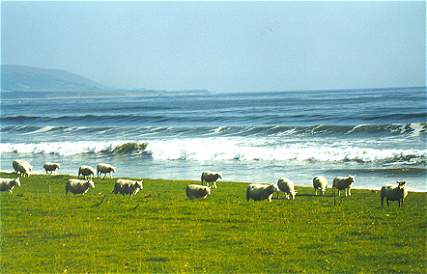
Brora is natural golf at its finest.
- Brora: A delightfully old fashioned Scottish Links. A good mixture of open expanses, blind holes, wee burns to torment, and a very subtle Braid design. The omnipresent sight of sheep and cattle grazing is deeply soothing to the golfer, and being 25 minutes north of Royal Dornoch, there is an isolation that few can match. It has been Peter Thomson’s links hideaway for many years and home to the James Braid Society. The links does not pretend to be ‘big-scale’ but it will please any one who takes the trouble to visit.
- Lossiemouth (Old Moray): When one links enthusiast says this is a treat – discount it as him having consumed too much Scotch Whisky. When another on the same trail sings its praises, look it up on the map. While sitting in a B&B named Hopefield House, Gullane, one learned gent who had played most links, nominated it as his favourite but couldn’t describe why – but I did notice him getting misty-eyed. With the urgency of getting to Royal Dornoch, people pass by it, a they often do with Nairn, and rely on hearsay. Just like I am.
- Machrie: Peaceful little ‘low-scale’ links on the Isle of Islay. Embodies most of the raditional Scottish elements and due to remoteness is not over-run.
10. What are the greatest threats to links golf?
(1) COASTAL EROSION and the clubs’ inability to wage a fair fight fight with their main adversary – NATURE. Every now and again, the R&A organise a grant to help out a Club battling erosion, but often the funds provided are inadequate and the work is commenced too late. Groynes, rock armour, sea gabions, mixtures of soft & hard techniques, chesspale fencing, dune rejuvenation can be very expensive.
(2) OVERWATERING leading to ephemeral grass species and conditions alien to Links Golf.
(3) Clubs that suddenly acquire BIG BUDGETS for their layout – a great chance to compromise what nature provided!
(4) In the commercial age, with EASE OF AIR TRAVEL, there is the threat of CROSS-POLLINATION of golfing genres. More British Links golfers than ever are travelling to sample the LUSH delights of foreign golf courses. Upon returning to their own barren, windswept links, the more ignorant among them are ‘bending the ears’ of British committees. ‘Hey, let’s spruce it up a bit?’ ‘How about planting a tree over there’? Over time, this quiet pressure can mount and produce problems.
(5) POOR WAGES. Due to many of the great links centres being in sleepy hollows, there is often very little money in the townships/villages. And so they have become overly reliable on the golf trade to survive, placing an extra burden on the links.
(6) TELEVISION is contributing to changing links conditions. This medium dishes up a steady diet of US Tour golf, and inevitably, golf professionals going for the pin (like Lanny in his heyday) and spinning the ball ferociously. We have already seen evidence that this over-exposure is impairing the judgement of too many Links Clubs.
(7) GOLF PROFESSIONALS are not playing a large enough role in discouraging the R&A to stop all this nonsense. High profile professionals, those with Links knowledge and architectural conscience should be speaking out more sternly.
(8) COMMITTEE Poor continuity, too rapid a turnover and in too short a time span. Let the good ones have the job for life. I suspect this is the case with most golf clubs around the world.
(8) The ROYAL & ANCIENT seem reluctant to lead by example and protect the rich heritage of British Links Golf.
Footnote: As golfers are becoming more aware of the architectural excesses of the 1980s, many ‘stadium’ style courses have come to be viewed as repugnant. Increasingly, they seek solace in the uncomplicated gift of Links Golf which further places strain on resources.
11. Muirfield has long been hailed for its superlative routing. What are some other examples of routings that take full account of the wind?
- Portmarnock
- Royal Portrush
- Brora
- Royal Porthcawl
12. What is your favourite links built in the past thirty years and why?
Before I answer that, my least favourite is Ballybunion New. Just a disaster, a wasted opportunity and on-going embarrassment for this great Club. I have not played Kingsbarns but will right that wrong soon. From everything I hear, it is a tremendous layout and a real feat, construction wise. Due to the political clout that Sir Michael can bring to any project, there is a push for rota inclusion in the near future. Unlike other touted inclusions, it does have the infrastructure to host the Open. I hear from some sources that the links is surprisingly lush, but I hope this is a case of poor reporting? What have we got? Craighead, Skibo, Ballyliffin New (Glashedy), The European, Doonbeg, Ballybunion New (Cashen), Portmarnock Golf & Hotel (IMG), conversion of the old Ladies Course at Royal Dornoch to the present Struie Course, Ceann Sibeal, Waterville, Connemara, Tralee, Carne, and several others.
I will say Waterville is my favourite, despite it having the most uninspiring 1st and 2nd holes in Links golf – maybe of any course in existence?
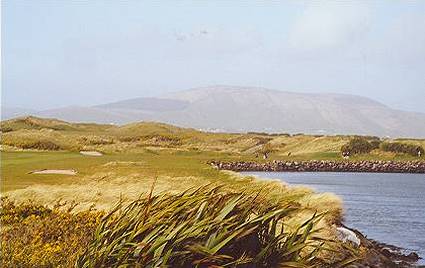
The 3rd at Waterville hugs the water.
The 18th is anti-climatic although steps are underway to address that. Notwithstanding these drawbacks, a good deal of the holes like the 3rd hugging the water, the exciting dunal par three 4th, Tranquillity, Judge, Vale, Mass, 16th of Liam Higgins hole-in-one fame, and Mulcahy’s Peak make you really want to play golf.
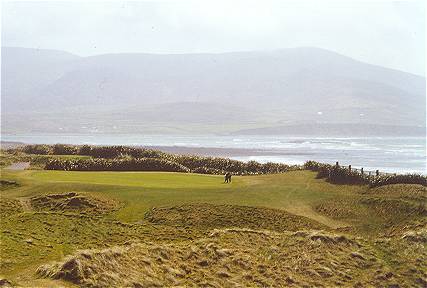
Mulcahy’s Peak – the 17th at Waterville.
All of this takes place in a remote part of Ireland complete with awesome scenery, both on and off the links. It is worth mentioning the opinion of Nick Faldo, an excellent designer, who claims that Ballyliffin OLD is the most natural links, and among the most enjoyable he has ever encountered. In addition, Ballyliffin Golf Club has the unique distinction of building two new links since the Second World War. The Glashedy Links is a fine track with tremendous views and impressive terrain.
If you had extended the question back to the last 55 years, nominating Turnberry (after Ross’ war-time clean up) and Southerness would be my picks.
13. What was involved with publishing Links Golf – The Inside Story?
It was quite an adventure and initially fraught with much nervousness. Quite a few publishers declined the manuscript on the basis that Links Golf was earmarked NICHE only. I was politely told my book would sell 100-1000 copies maximum, which constituted a big ‘risk’ for them. Anyhow, the book was self-published and I have now sold 4000 copies from an initial 5000 print-run. Being shortlisted with two other books (The Toronto Terror & Mr Jones/Hagen) for the USGA International Book of the Year Award – 2000, vindicates my faith in risking financial ruin. In addition, Pelican Publishing, Louisiana, has picked it up and we are currently negotiating a US Edition. They have a number of golf books in their stable including two excellent Keith Mackie books.
14. If a friend was heading to the United Kingdom and Ireland for the first time for a two week golfing trip, what 14 courses would you suggest that he play in order to gain a broad perspective on the appeal of links golf?
The idea would be to expose that person to a cross-section of Open Championship Links, high quality layouts not on rota, antiquated/quirky centres of historical importance, and others that are just pleasant strolls and transmit the links feel. It is misguided to lust after the big name links only. Also if time permitted, give Wales a chance. Almost everybody gives it a miss and that is partly due to their poor advertising, partly visitor time constraints.
- The Old Course, St Andrews
- Prestwick (Old)
- Cruden Bay
- Lahinch (quickly before Hawtree’s renovation)
- North Berwick
- Machrie
- Royal Dornoch
- Royal North Devon (Westward Ho!)
- Rye
- Ballybunion Old
- Brora
- Royal County Down
- Tenby
- Muirfield
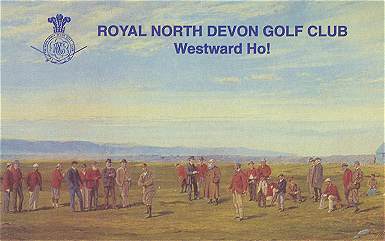
Few clubs enjoy as rich a history – or as good a course – as Westward Ho!
But substitute Portmarnock, Co Sligo, Aberdovey, Saunton (East or West) or Brancaster and the Links experience would be equally seductive and educative.
15. What are some blind shots that you admire? What are some that you don’t care for?
For me, the ‘big daddy’ of all blind drives is the 9th at Royal County Down. It is exciting, intriguing, and for the first time visitor – a tad scary. The approach to ‘Perfection’ at North Berwick gives you reason to pause, especially with the lurking ocean over green. However, the challenge is incomparable to what faced golfers of yesteryear- ‘heart in mouth’ with wood shots.
The approach to Carnoustie’s 1st hole is noteworthy. Taking on the ‘braw’ line down the left side opens up the green appreciably, but at the risk of possibly finding the burn. I am impressed by the concept of ‘blindness by misadventure’. In other words, the approach to Carnoustie’s 1st green becomes progressively ‘blind’ the further right you drive for safety. Even the knockers of blind golf can find something to embrace in this philosophy.
The second shot at Lahinch’s par five, 5th hole – legal implications and everything else considered. Hit one slightly thin, and your ball buries itself into the layered hill. Unlikely to be designed today. The tee shot at the Dell (following hole), complete with movable white rock to indicate pin position is a standout blind hole – one of the most challenging and fun types.
While generally okay about blind shots on a links, I am not a huge fan of ‘Blin Dunt’ (15th) at Cruden Bay. At 239 yards, it is too long to demand that the golfer drives diagonally across the brow of a hill.
16. Which five links possess the greatest green complexes?
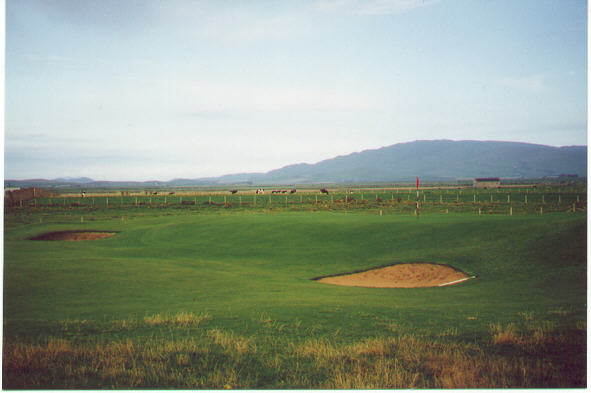
Note the false front to the 13th green at Macrihanish.
- Machrihanish
- The Old Course – (possibly influenced by sentiment)
- Ballybunion (Old)
- Turnberry
- Muirfield
17. What does the future hold for the construction of new links courses in the United Kingdom and Ireland?
For twenty years we have been reading statements, ‘This will be the last true Links built in Britain!’ And yet, they keep coming. Perhaps money is being passed ‘under the table?’ By necessity, architectural firms, clubs and interested parties are becoming better equipped to tackle the thorny issue of the ‘Green’ movement, conservation… and so on. One shining example was Donald Steel in the manner he gained permission to lay out the Carnegie Club, Skibo. Rather than convincing the authorities of the need to construct a new links, his low-flying ‘selling’ mission proved that a links existed 100 years ago on the same site; albeit grassed over. A few old tees and green complexes were detected and so the licence was granted. I see this happening more often as people dredge up old archives and locate now defunct clubs.
A common misconception is that Great Britain & Ireland is wall-to-wall linksland. Indeed extensive areas of coastline are devoid of linksland. Unbelievably, there is only 300 miles of true linksland in Scotland. Not much is happening in conservative England, nor in Wales to my knowledge – perhaps due to basic Welsh reticence. Connected to this question, has been the push to exploit linksland amidst the cooler climes of Australia’s southern states. There has been a flurry of activity recently in Tasmania – an old penal colony where naughty Brits were sent for stealing loaves of bread. One of Tom Doak’s top men visited recently.
18. The Australian coastline from Melbourne west to Adelaide is rich with natural links land. Do you think that the economics and the regulatory conditions will ever be favourably for building a world-class course?
I have a feeling that this region will eventually be developed, but in light of a ‘sensitive’ aboriginal agenda currently, there are hurdles to overcome. It all relates to scared midden sites and displacement. One area, known as Killarney Beach, (part of the Belfast Coastal Reserve), has incredible linksland for many miles.
At least 5-7 links could be routed one after another – shades of Lancashire/Cheshire, UK. A well-respected designer, Michael Clayton, has expressed great interest in the area and made exploratory trips. No doubt, others have as well.
Being between two big population bases – Adelaide and Melbourne, there are sporadic golf clubs already existing. One dilemma is: What are the members to do? Quit their current Club to join the new links, or keep two memberships? This area of Australia is not renowned for great wealth! One solution would be to have Clubs relocate (as did Muirfield) and keep their existing members. But of course, not everyone likes to travel and the vote would be ‘dicey’ on AGM day. However, if the regulatory hurdles could be overcome, several links would surely spring up in near proximity. Then the area becomes a destination, like Fife or Kerry, and people have a reason to stay for a week. B&Bs start up and the local trade is happy.
In my book, I showcase some of the stunning Killarney linksland. This was risky business in light of the ‘Keep Out’ signs.
The End








